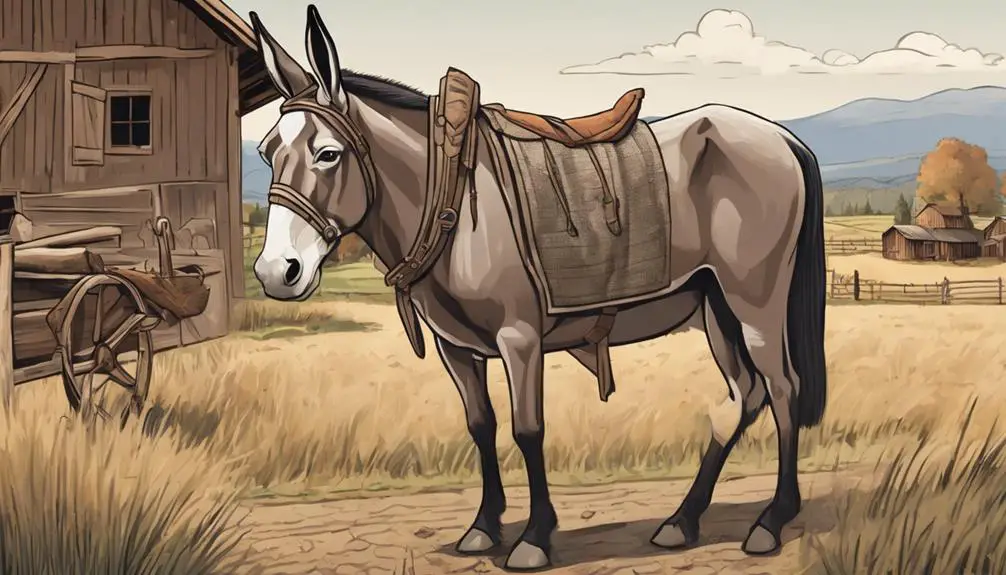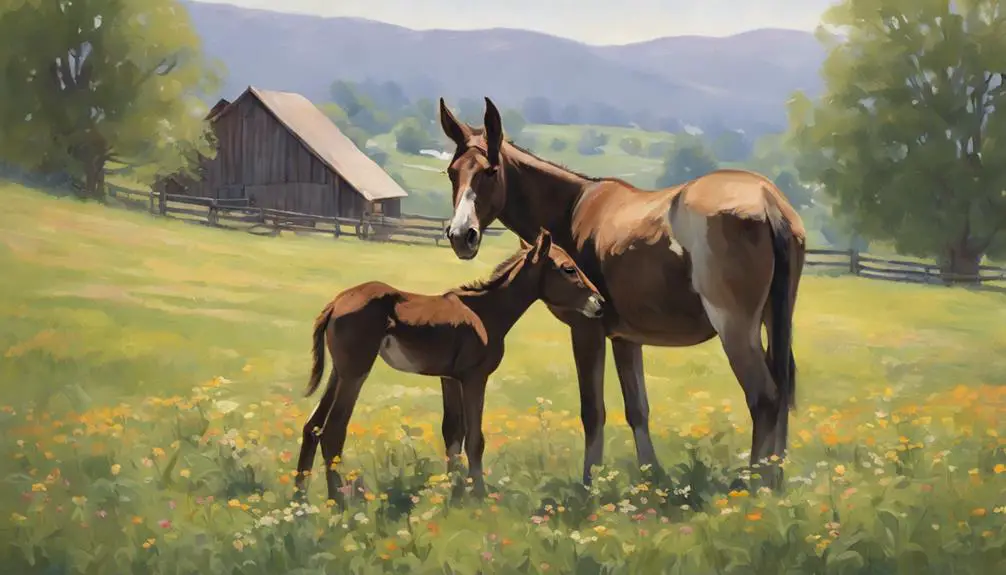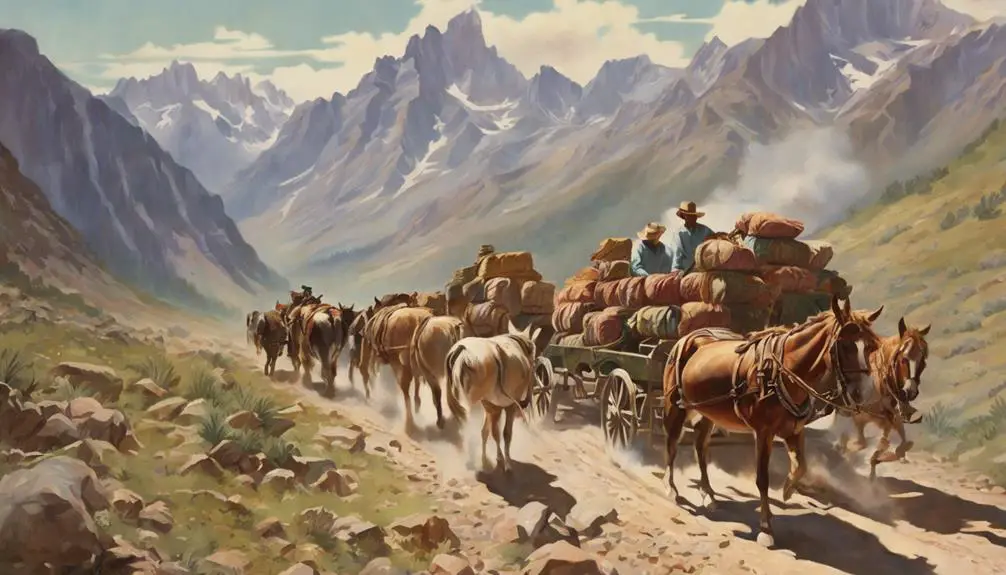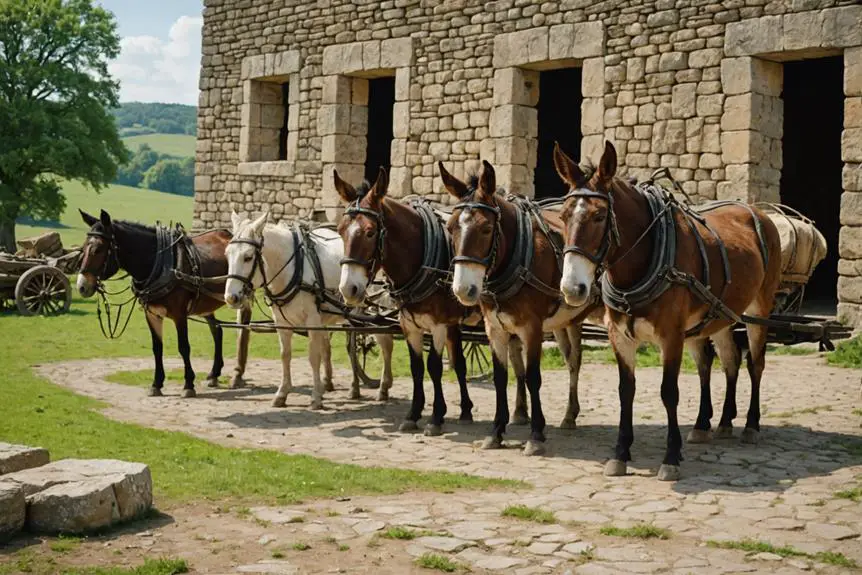Mules have shaped economies, transformed landscapes, and influenced cultures. From their origins in ancient Paphlagonia to their pivotal roles in modern agriculture, these hybrid animals have proven their worth across millennia. You might wonder what makes mules so unique, or how their characteristics have adapted to human needs over time. As we explore their remarkable history, you'll uncover the many ways mules have not only survived but thrived alongside us, challenging perceptions and expectations at every turn.
Definition and Characteristics

Mules are often regarded as one of nature's fascinating hybrids, resulting from the crossing of a male jackass and a female horse. These incredible animals possess a unique blend of characteristics inherited from both parents, making them truly remarkable.
Typically, mules stand between 50 to 70 inches tall and weigh anywhere from 275 to 700 kg, showcasing significant variation based on breeding and individual traits.
One of the most striking features of mules is their superior intelligence and endurance. Compared to horses and donkeys, mules often display advanced problem-solving abilities and excellent memory, proving to be sociable companions.
While they possess 63 chromosomes, mules are generally sterile, which means successful reproduction is quite rare, though female mules may still experience estrus cycles.
Mules also exhibit hybrid vigor, inheriting beneficial traits from both the horse and the donkey. This results in greater muscle power, natural disease resistance, and the ability to thrive on lower-quality fodder.
Historical Context
The remarkable traits of mules have made them integral to human history for thousands of years. In ancient times, mules were bred for their exceptional strength and endurance, quickly becoming the preferred pack animals in various cultures. Their first known breeding occurred around 3500 BC in regions like Paphlagonia and Nicaea, modern-day Turkey.
Historical texts, including the Bible and works by Homer, highlight the significance of mules, showcasing how highly valued they were, especially by the Hittites, who considered them worth three times more than chariot horses.
In ancient Israel, mules were favored by royalty, often referred to as the "Royal Beast." These sturdy animals played a vital role in transportation, making them indispensable during the westward expansion of the United States in the 1840s.
As settlers moved westward, mules were utilized on wagon trains, averaging an impressive 30 miles a day. Their ability to navigate various terrains and carry heavy loads cemented their place in history, reflecting humanity's reliance on these remarkable creatures for survival and progress.
Mules haven't only shaped economies but have also left an indelible mark on our cultural heritage.
Fertility and Reproduction

Understanding the reproductive challenges of mules reveals much about their unique biology. Mules, the common hybrid offspring of a male donkey and a female horse, possess 63 chromosomes, an odd number that typically results in sterility. This makes successful reproduction among mules exceedingly rare, particularly for female mules, known as molly mules.
Though they may experience estrus cycles, the chance of a molly mule conceiving is low, with documented pregnancies being remarkably scarce. Historically, only about sixty documented cases of mules giving birth exist from 1527 to 2002, leading many to view these accounts with skepticism. The most recent verified case of mules giving birth happened in Colorado in 2007, further highlighting the rarity of this phenomenon.
However, researchers continue to explore the genetic factors that influence fertility in mules. Occasionally, rare cases of fertility emerge, offering a glimmer of hope for successful reproduction. While mules may be celebrated for their strength and endurance, their reproductive journey remains one of nature's intriguing mysteries, reminding us of the complexities woven into their genetic tapestry.
Contemporary Uses
How do mules continue to play an important role in today's world? These remarkable animals excel as pack animals, making them invaluable in rugged, roadless areas where vehicles can't venture. In industries like construction and mountaineering, mules transport supplies with impressive endurance. They can carry as much as 30% of their body weight—up to 160 kg—over distances of 25 km without resting, showcasing their strength and stamina.
Mules also serve a crucial role in modern tourism. Their unique characteristics make them the perfect companions for trail rides and guided tours in mountainous regions, allowing adventurers to explore scenic landscapes while enjoying the company of these gentle giants.
Additionally, herders still prefer mules for their ability to thrive on lower quality fodder and their patience, especially compared to horses.
Their historical significance in wartime logistics, such as during the Soviet-Afghan War, underscores their reliability in challenging terrains. Despite the rise of mechanization, mules continue to hold a special place in various sectors, demonstrating that their legacy isn't just in the past, but very much alive today.
Mule Trains

Mule trains, made up of pack mules carrying cargo in a line, showcase the incredible sure-footedness and resilience of these animals in rugged terrains. Historically, they've been essential for bulk transportation, dating back to pre-classical times.
These efficient pack animals can carry approximately 30% of their body weight, translating to about 90 kg in dead weight or cargo. This capacity made them indispensable during the westward migration in the 1840s, where they could cover up to 30 miles a day, far outpacing horse-drawn wagons.
Today, mule trains continue to thrive, particularly in remote areas where traditional vehicles can't tread. In the Sierra Nevada, at least sixteen commercial mule pack stations operate, transporting supplies through the rough terrains that only these magnificent creatures can navigate effectively.
Whether you're traversing mountain trails or delivering goods to isolated communities, mule trains remain a reliable and efficient means of transportation. Their long-standing history and adaptability highlight the mules' significance in both past and present logistics, making them a fascinating topic for anyone interested in the evolution of cargo transport.
Cultural Significance
Throughout history, the mule has held a significant place in various cultures, often seen as a symbol of strength and endurance. These remarkable animals have been depicted in ancient art dating back to 1350 BC, emphasizing their integral role in societies like those in Egypt and Greece. In many cultures, mules represented nobility and military prowess, making them the preferred choice for royalty during transportation and ceremonial events.
Literature, including works by Homer and references in the Bible, highlights the cultural significance of mules in agriculture and transport, showcasing their value throughout history. Their contributions extended far beyond mere labor; they became woven into the fabric of local traditions and livelihoods.
Mule Day events celebrate this cultural impact, drawing communities together to honor the mule's historical importance in farming practices.
Today, modern mule organizations and websites work tirelessly to promote awareness and appreciation for these incredible animals, ensuring their legacy continues in contemporary agriculture and tourism sectors.
Frequently Asked Questions
Why Were Mules Used Instead of Horses?
You'd choose mules for their endurance, strength, and versatility. Their calm temperament and unique behavior make training easier. Mule advantages, like hybrid vigor from breeding, enhance characteristics that outshine horses in various challenging environments.
What Does the Mule Symbolize?
Mules symbolize endurance and strength, embodying loyalty and stubbornness. Their hybrid vigor highlights agricultural importance, while cultural depictions showcase their historical significance as reliable pack animals, representing resilience against adversity throughout various landscapes and challenges.
Who Brought Mules to America?
You'd learn that Spanish Conquistadors first brought mules to America, enhancing colonial agriculture and transportation innovations. Their strength aided Southern plantations, trade routes, and even during the Gold Rush and Civil War, traversing challenging mountain trails.
What Are Some Interesting Facts About Mules?
You'll find mules are like superstars in the animal world! With strength, intelligence, and endurance, their behavior shines. They live long, thrive on hay, and debunk myths—more reliable than donkeys in work and training!



